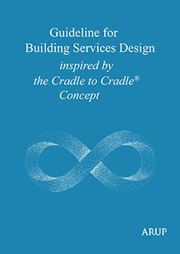Arup’s new guidance document is an important contribution to the field of C2C design, outlining its application for the different disciplines that make up building services:
-
water installations
-
gas installations and fuel supplies
-
heating systems
-
ventilation systems
-
cooling systems
-
electrical installations
-
extra low voltage (ELV) installations
-
vertical transport
-
usage-specific/specialist systems
-
building management/controls systems
The guideline provides a set of overall aims and realistically achievable design criteria for the application of C2C in each of the above disciplines, offering an indication of the aspects to consider in each design phase (from establishing the brief, to the system selection and sizing as well as material selection). Taking up the concepts of ‘eliminating waste’ and ‘design for disassembly’, it also covers material selection and construction methods, ensuring that the employed materials can be recycled and re-used at the end of their useful life, making the building a ‘material bank’.
William McDonough, globally recognised leader in sustainable development and co-author of the 2002 book ‘Cradle to Cradle: Remaking the Way We Make Things’, welcomed the report’s depth in the foreword, while acknowledging the challenges that lie ahead.
“This Guideline is an important and bold first step, and one that will hopefully lead to much discussion and debate. I applaud the effort to bring rigour to the endeavour, and look forward to continued, elegant refinement”, says William McDonough in the foreword.
Driven by its ambition to shape a better world, Arup has worked on a range of sustainability projects that seek to deliver a long-lasting positive impact for society at large; in developing the guide, the Arup team drew from this impressive global experience.


